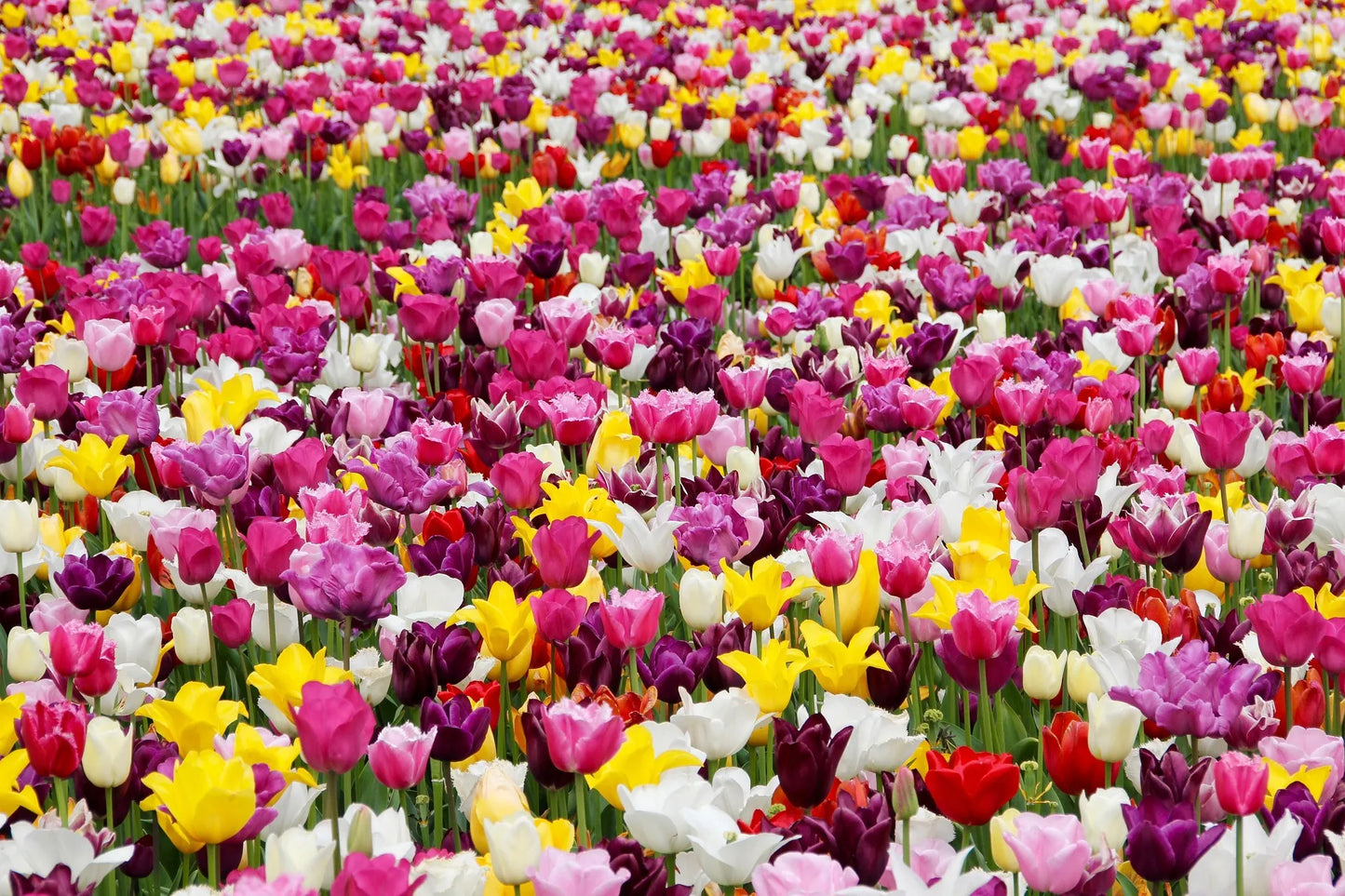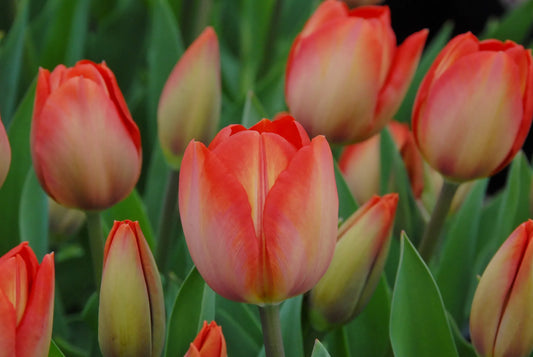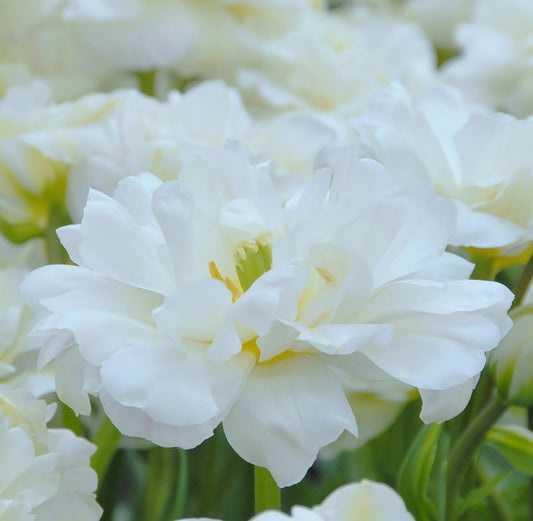-
Livraison dès 10 bulbes France, Suisse et Europe
Modalité livraison -
Grossiste Bulbes de fleurs en ligne
-
Bulbes de Qualité
-
Paiement sécurisé
Virement / chèques / Carte Bancaire /Chorus
Untreated flower bulbs Tulip Quebec size 12/+ (1013600)
Untreated flower bulbs Tulip Quebec size 12/+ (1013600)
PRICE per bulb € excluding VAT excluding transport
Delivery from mid-September to November - choice at the basket stage
Online shopping available in France and Belgium. For other countries, please request a quotation.
Couldn't load pickup availability
 Limited stock - Buy now and get it delivered when you're ready to plant
Limited stock - Buy now and get it delivered when you're ready to plant
- Delivery from 10 bulbs to France, Switzerland and Europe
Flower Color:
Usage:
Flowering:
View full details

Quality Tulip Bulbs for Florists and Individuals
Quick read / the essentials about our Tulipa gesneriana Tulip Bulbs
Floriculture professionals, are you looking for a reliable solution for your tulip crops? Floriverse , your wholesale supplier specializing in flower plants , offers you a complete range of Tulipa gesneriana tulip bulbs adapted to the different specifications of French flower production. Our offer covers all segments: high-yield conventional bulbs , untreated bulbs for sustainable production, and certified organic bulbs to meet the growing expectations of the eco-responsible market. This technical diversity allows producers to buy Tulipa gesneriana tulip bulbs according to their certification objectives, the desired level of intensification and their production schedule (forcing, open-field cultivation, greenhouse cultivation). As a wholesale supplier specializing in flower plants , Floriverse is committed to traced batches, personalized technical advice, logistical responsiveness and competitive prices, to allow you to plan your campaigns with peace of mind. Thanks to our mastery of the market and the requirements of the sector, we allow you to buy professional quality Tulipa gesneriana Tulip bulbs , suitable for the production of cut flowers, landscape naturalization or short supply chains. By relying on the expertise of Floriverse, a specialist wholesale supplier of flower plants , you are choosing a committed partner, capable of supporting French floriculturists in the revival of national tulip production.
Introducing our Tulip range
Our company offers a wide range of tulip flower bulbs , specifically selected to meet the requirements of professional floriculture growers. We offer diversified solutions including certified organic bulbs, untreated bulbs and conventional bulbs. This diversity, including a wide range of organic tulip flower bulbs , allows us to effectively meet the varied needs of floriculture professionals, whether they are aiming for organic or conventional certification.
Market approach: Tulip cultivation in France
State of the Cut Tulip Flower Market in France (2022-2025)
The French cut flower market is characterized by a high dependence on imports (around 85%), mainly from the Netherlands. Despite this dependence, demand remains stable, placing the French market in a dynamic global context, valued at $32.6 billion by 2025, with annual growth estimated at 6.3%.
Specific situation of the tulip on the French market
In France, tulips accounted for approximately 6% of individual cut flower purchases in 2022, ranking third among the most cultivated species by French producers. This share, slightly down from previous years, nevertheless highlights significant potential for recovery through local production.
National production of cut tulips
National production is dominated by key players such as the Bigot Fleurs company in Sarthe, which alone produces more than 35 million stems per year. This concentration demonstrates both French technical expertise and development opportunities for other regions and producers.
Geographic distribution
Two regions dominate the French cut flower market:
- PACA region: 42% of national production.
- Pays de la Loire: 41% of national production, with a marked specialization in tulips, notably via Bigot Fleurs.
Recent market developments (2022-2025)
After a difficult period due to the health crisis (wholesale sales fell by up to 48%), the market is seeing a notable recovery with the emergence of numerous small farms and flower farms. This trend, combined with a growing demand for local products, is creating interesting opportunities for tulip growers.
Distinction between organic/untreated market and conventional market
Production without pesticides
The French market leader, Bigot Fleurs , has been producing its tulips without pesticides, certified High Environmental Value (HVE), since 2021, marking a strong trend towards more sustainable agricultural practices.
Challenges of the organic market
The development of organic production faces significant technical constraints, particularly due to the non-approval of many phytosanitary products necessary to ensure the aesthetic quality required by the market.
The advantage of labels
The "Fleurs de France" label constitutes a significant competitive advantage, guaranteeing local production committed to an eco-responsible approach and thus contributing to strengthening the commercial attractiveness of certified bulbs.
Outlook for bulb suppliers
Opportunities for your business
Your business selling tulip bulbs to professional florists benefits from a favorable context marked by:
- A desire to relocate and promote national production.
- A transition to sustainable production methods.
- A growing need for technical support for new producers in reconversion.
Segments to develop
Two main segments clearly emerge to meet current market expectations:
- Optimized conventional segment: varieties adapted to intensive production targeting medium to large farms.
- Organic/untreated segment: specific varieties adapted to pesticide-free crops, requiring enhanced technical support and promotion of HVE or organic certifications.
Complete Technical Sheet of the Tulip (Tulipa gesneriana L.): Reference Guide for Professional Production
The tulip, scientifically known by the full name Tulipa gesneriana L. , belongs to the botanical family Liliaceae . This species is the most commonly cultivated commercially, both for the production of cut flowers and bulbs , in France and worldwide. The genus Tulipa is rich and has around 100 to 120 wild species according to estimates, but it is Tulipa gesneriana that dominates the horticultural market , giving rise to several thousand cultivars . It is technically relevant to use the name Tulipa gesneriana L. (family Liliaceae) on a site intended for an informed professional clientele.
Tulips are monocotyledonous plants classified as bulbous geophytes , characterized by a stem generally bearing a single flower , although some cultivars may have several flowers per stem, thus providing a diversity appreciated in arrangements and bouquets.
The geographical home of the tulip (Tulipa spp.) is located mainly in Central Asia , in the steppes and mountainous areas of Kazakhstan, Uzbekistan, Kyrgyzstan, Tajikistan, northeastern Iran and Afghanistan , territories where the greatest natural diversity of wild species is observed. The natural habitat of the tulip is marked by a continental climate , characterized by cold, often snowy winters and hot, dry summers . This significant seasonal variation is crucial, as it induces summer dormancy in tulips, a cycle essential to their survival and development .
Depending on the species, wild tulips are mostly found at altitudes between 500 and 1,500 meters , thriving in varied biotopes such as dry steppes , rocky slopes , subalpine meadows and open lawns . They prefer well-drained soils , often stony or gravelly, where plant competition is low. This natural ecology explains the robustness of the cultivated tulip , its imperative need for well-drained soils to prevent bulb rot and the importance of a dry summer period for their conservation.
The Tulip Bulb: Morphology and Professional Standards
The tulip bulb is a tunic bulb , protected by a thin outer shell , light brown to medium brown in color, or even slightly silvery depending on the variety and stage of maturity. This tunic provides natural protection against drying out and disease .
Internally, the bulb consists of fleshy, white scales , rich in nutrient reserves for the plant. The bulb shape is typically ovoid to subglobose , with an often flattened base from which the roots emerge.
For growing professionals, standard bulb sizes , expressed in circumference , are generally between 10/11 cm and 12/14 cm . Bulbs of size 12/+ (greater than 12 cm in circumference), corresponding to a diameter of approximately 3 to 5 cm, are particularly popular because they guarantee more robust and uniform flowering . Professionals systematically favor well-sized, healthy bulbs without signs of disease .
Foliage: Key Role in the Vegetative Cycle
Tulip foliage , although often aesthetically underestimated after flowering, plays a central role in its growth cycle and bulb quality . Tulips develop a limited number of leaves , arranged alternately on the stem, with a fleshy texture and shallow veins .
The base of the leaves, thickened inside the bulb, constitutes nutrient reserves essential for initial development and flowering. Once out of the ground, these central scales transform into chlorophyll leaves , ensuring photosynthesis , a vital process for the replenishment of the bulb's reserves after flowering .
The leaf growth period, during spring, is crucial for capturing light energy and producing the necessary sugars . After flowering, photosynthetic activity allows the bulb scales to regenerate. The natural yellowing of the foliage , which persists until July, signals the end of the active growth cycle . It is essential not to cut the foliage prematurely , because its quality directly impacts the final size of the bulb and the vigor of future flowering .
Flowers: Variability, Classification and Professional Use
Tulip flowers offer considerable technical diversity for professionals. The flower typically has a cup-shaped or goblet-shaped corolla , composed of six tepals (undifferentiated petals and sepals).
They can be single or double , depending on the variety. The height of the stems varies from 18-20 cm to more than 60 cm depending on the horticultural group, and the floral diameter is generally between 5 and 10 cm , or even more for giant varieties. The color palette is exceptionally rich: red, yellow, orange, pink, purple, white , as well as bicolor or flamed varieties . Some have wavy or fringed edges .
Most tulips produce a single flower per stem , although some multi-flowered exceptions exist. Fragrance is generally absent , except in a few botanical varieties. For professional cultivation, the flowering period is essential: in France, early varieties flower as early as March , mid-season varieties in April-May , and late varieties until June .
The technical classification into horticultural groups (Single Early, Double Early, Triumph, Darwin, etc.) is a key tool for choosing the right cultivars according to the desired earliness. Forcing , including a cooling period at 5°C for at least 6 weeks, is an essential technique for the production of cut flowers in unnatural periods.
The professional production cycle may involve cultivation in two years : the first outdoors for the production of flowers and bulbs , then cultivation in a cold greenhouse the following year for larger bulbs after heat treatment .
Height, Port and Horticultural Classification
The height and general shape of mature tulips vary significantly depending on the species and variety being grown. Typically, tulips reach a height of between 10 and 75 cm .
Specific horticultural divisions have distinct heights:
- Double early (Division 2): 30 to 40 cm
- Triumph (Division 3): 36 to 61 cm
- Darwin hybrids (Division 4): 50 to 70 cm
- Late singles (Division 5): 45 to 75 cm
- Fleur-de-lis (Division 6): 45 to 60 cm, tapered petals
The habit is mostly upright , with stiff stems depending on the cultivar. The calyxes are often campanulate and can be simple, double or fringed , offering valuable diversity for cut flowers or landscaping .
Spring Bloom: Professional Calendar
In France, the tulip flowering period mainly extends from March to May . This three-month window is crucial for production planning and marketing .
The varieties are classified according to their precocity :
- Early : flowering from March (south) or April
- Mid-season : April-May
- Late : May to early June
Since individual flowering times are short, strategic use of a variety mix allows for a longer marketing period . Success depends on planting between October and December , 10 cm deep , in well-drained soil at an optimum temperature of 10°C . Exposure to winter cold is essential for their development.
Hardiness and USDA Zones
Tulips are suitable for USDA zones 3 to 8 , which means a tolerance of -40°C to -6.7°C . France is mainly located in zones 6 to 9 , which allows for widespread cultivation.
In the hottest zones (8-9), technical adaptations are necessary:
- Pre-cooling of bulbs
- Store at approximately 4.4°C for 6 weeks
Planting is ideal when the soil temperature at 15 cm is 15.5°C or lower. In very warm zones (9-10), tulips can be treated as annuals .
Life Cycle: Limited-Life Perennial
Botanically, the tulip is a geophyte perennial . But in professional cultivation , it is often managed as an ephemeral perennial because flowering is optimal in the first year.
The annual cycle includes:
- Autumn : planting and rooting
- Winter : underground dormancy
- Spring : emergence and flowering
- Summer : dormancy after yellowing of the foliage
Flowering decreases markedly from the second year for hybrid varieties . This is why the bulbs are pulled up each year after flowering and replaced to ensure consistent quality.
Professional Propagation: Methods and Performance
Tulip propagation can be done by:
- Bulbils produced naturally around the mother bulb
- Chipping / Scoring : manual division techniques
- In vitro culture for mass multiplication
Tissue culture allows for the production of 500 to 2000 microbulbs per year from a single healthy plant, using scale segments. Thidiazuron (TDZ) is often used as a growth regulator.
The advantages of micropropagation include:
- Virus-free plants
- Rapid multiplication
- Commercialization of new genotypes
Varietal Choices and Strategic Cultivars for Professionals
The choice of cultivars is a strategic decision for French producers. The reference species remains Tulipa gesneriana , called "florists' tulip" , which offers an exceptional diversity of shapes, colors and flowering periods through more than 4000 horticultural varieties .
Some relevant professional cultivars :
- 'Ile de France' (Triumph): dark red, 45-50 cm, mid-season
- 'Mrs. John T. Scheepers' (Single Late): bright yellow, 60-80 cm, late flowering
- French Tulips : 60-90 cm, late flowering, popular in luxury floristry
- 'Queen of Night' (Single Late): very dark purple, 60-70 cm
- 'Purissima' (Fosteriana): pure white, 35-40 cm, early flowering
- 'Carnaval de Nice' (Double Late): white/red, 40-55 cm, late flowering
Selection criteria include: height (20 to 90 cm), earliness (March to May) and color . The giant tulips of Carqueiranne are a local specialty highly sought after in the high-end market .
Tulip Toxicity: Professional Precautions
All parts of the plant are toxic to humans and livestock , especially the bulb, due to the presence of tulipalin A and B.
Human risks:
- Contact dermatitis common in professionals ("tulip fingers")
- Digestive symptoms if ingested: nausea, vomiting, diarrhea
Animal risks:
- Digestive toxicity rare but possible in cattle, sheep, goats
Recommendation : Wear gloves when handling bulbs . Note that there is no protected status for cultivated varieties of tulips in France.
Technical Advantages and Limitations of Cut Flowers
Tulips offer many technical advantages as cut flowers :
- Long stems (40 to 60 cm), rigid when cut
- Holds well in bouquets , especially if cut in bud
- Elegant visual appearance , post-cut growth providing movement
Technical limitations:
- Post-cut bend : the stem continues to grow and may become deformed
- Average shelf life in vase : approximately 7 days
- Perfume generally absent
To optimize the hold : cut the stems regularly, use the firmest flowers.
Landscape Use and Integration into Developments
Tulips fit easily into flowerbeds, borders and rockeries . Planting in groups is recommended to maximize visual impact .
Technical advice:
- Spacing: 15 to 20 cm between bulbs
- Planting period: September to end of November
- Planting depth: 10-15 cm , point upwards
Botanical tulips are ideal for borders and rockeries . In floral association , they go very well with:
- Pansies , violas , daffodils , hyacinths
- Crocuses , miniature irises , ground cover roses
- Peonies for harmony with peony-flowered tulips
Naturalization Capacity and Resilience
Darwin's botanical species and some hybrids have excellent naturalization capacity if the following conditions are met:
- Phosphorus-enriched soil (bone meal or manure)
- Optimal drainage (gravel/sand)
- Planting depth = 3x bulb height
- Systematic removal of faded flowers
- Maintaining foliage until complete yellowing
Constant soil temperatures around 10°C for at least 6 weeks are necessary for optimal root development.
Use of Communities and Public Spaces
The tulip is a very relevant option for communities and green space managers :
- Ease of maintenance
- Moderate watering only in dry periods
- Good resistance to classic climatic conditions
- High visual performance with controlled costs
Simple and early varieties (18-20 cm) are suitable for mass plantings for their uniformity and wind resistance . The recommended spacing is 10 to 15 cm .
To ensure the sustainability of plantations , it is essential to allow the foliage to develop after flowering . The ideal soil should be:
- Light and well drained
- Slightly acidic to neutral pH (6 to 7)
Attractiveness for Pollinators
Although tulips are not the richest nectar plants, they are mainly pollinated by insects ( entomogamy ), and are particularly attractive at the end of winter .
Insects concerned:
- Honeybees (Apis mellifera)
- Bumblebees (Bombus spp.)
- Some beetles and butterflies
To maximize their ecological interest, it is advisable to favor:
- Single-flowered varieties (richer in pollen)
Flowering between April and May coincides with a key moment in the pollinator cycle , providing a useful floral resource.
Professional Floral Associations
For visual and technical arrangements, tulips combine well with many plants:
- Pansies , violas : contrast or complement of colors
- Daffodils and hyacinths : for a layered spring bloom
- Crocus , dwarf irises : integration into rock gardens
- Ground cover roses and peonies : complementarity in borders
Possible planning by sequenced flowering calendar :
- February-March: early botanical tulips
- Early April: early singles and daffodils
- Mid-April to May: double tulips, parrot, fleur-de-lis, peonies
Sunny areas are best. For pots, use terracotta containers for better results than plastic.
Post-Flowering Management: Bulb Regeneration
After flowering (March to June), the tulip enters a crucial phase for its longevity. The foliage gradually turns yellow over 6 to 8 weeks .
Essential practices:
- Keep the foliage green as long as possible
- Cut off faded flowers (pruning) to avoid exhaustion of the bulb
Avoiding seed production allows the bulb to replenish its nutrient reserves . Once the foliage has turned yellow (in July), it can be removed. During this phase, it is possible to introduce summer bulbs (dahlias, lilies, gladioli, etc.) to maintain commercial interest.
Performance in Professional Culture
In cut flower production, we observe:
- 1 quality flowering stem per bulb and per cycle
The standard planting density varies between 60 and 100 bulbs/m² , i.e. an equivalent yield in quality stems .
Optimization factors:
- Choice of higher calibers (≥ 11/12)
- Cultural experience , choice of plot
- Practices: mulching, phytosanitary control, rigorous sorting
Forcing Technique: Off-Season Flowering
Forcing allows flowering outside the natural period, particularly in January-February .
Key technical elements:
- Pots ≥ 20 cm , drainage by clay balls
- Light, enriched potting soil, pH between 6 and 7
- Mandatory vernalization at 5-9°C for 12 to 16 weeks
- Return to temperature at 12-16°C after cold
Growing under cover requires:
- Controlled watering (1-2 times/week)
- Stable humidity
- Abundant but subdued light
- Reinforced phytosanitary surveillance
A phospho-potassium fertilizer at planting is recommended, with nitrogen limited after replanting to avoid excessively soft stems.
Soil and Drainage Requirements
Tulips require light, well-drained soil . The ideal texture is sandy or sandy loam .
Avoid heavy, clayey soils that retain too much moisture. In case of unsuitable soil:
- Add coarse sand
- Create growing mounds or raised beds
The optimal pH is between 6 and 7. Impeccable drainage is essential to avoid bulb rot , especially in winter.
Exposure and Light Conditions
For professional cultivation, full sun exposure is preferable. This promotes:
- Abundant flowering
- Stem vigor
Tulips tolerate light shade but do not like dense shade . Strong winds should be avoided to protect taller varieties.
To optimize visual impact and productivity:
- Prepare loose, healthy, well-drained soil
- Plant in autumn (September to November)
- Spacing of 10 to 15 cm recommended
Planting Calendar and Technical Parameters
Planting bulbs is ideally done between the end of September and mid-November , and until the beginning of December in the south of France.
Optimal conditions:
- Soil temperature: 10°C at the time of planting
- Rooting before the first frosts
- Depth: 10 to 15 cm , depending on the size
- Spacing: 10 to 15 cm between bulbs
Planting too late impairs rooting, reduces flower yield and exposes you to frost.
Professional Irrigation and Fertilization
Watering:
- Initial watering after planting to stimulate rooting
- Moderate but regular contributions in spring
- Complete shutdown in summer during dormancy
Fertilization:
- Soil amendment in the fall (compost, pH 6-7)
- Phospho-potassium fertilizer at planting
- Balanced NPK fertilizer (e.g. 5-10-5) in spring (30-40 g/m²)
- After flowering: fertilizer rich in potassium to strengthen the bulb
Avoid excess nitrogen which promotes foliage to the detriment of flowers.
Winter Protection and Mulching
In case of severe cold , mulching is recommended:
- Organic mulch (leaves, straw): 5 to 10 cm
- Winter sails P30 to P60 to protect against frost (< -7°C)
The planting depth (10-15 cm) is also a natural barrier against the cold.
Routine Maintenance
Essential technical actions:
- Regular weeding (every 15-20 days)
- Pruning after flowering to preserve the bulb
- Precise watering in spring, stopped after yellowing
- Lifting of the bulbs between June and July, drying at 18-20°C
A 5-10-10 type fertilizer is recommended in spring at a rate of 40 to 60 g/m² .
Diseases and Pests
Main phytosanitary problems:
- Bulb mites : weaken the plant
- Nematodes : destruction of bulbs → burning necessary
- Botrytis , Fusarium : rots
- Potyvirus : floral deformations, weakening
Prevention:
- Crop rotation from 3 to 5 years
- Certified healthy bulbs
- Optimal spacing and drainage
Harvesting and Storing Bulbs
The bulbs are harvested when the foliage is completely yellow , in May-June. They must be:
- Gently pulled out with a transplanter
- Sorted by caliber
- Dried for 1 month in a cool, ventilated place
The forcing bulbs undergo a heat treatment at 5°C . The bulbils are replanted for enlargement.
Professional Cultural Rotation
Do not replant tulips (or other Liliaceae) on the same plot before 3 to 5 years .
Favorable crops in rotation:
- Cereals (wheat, barley)
- Green fertilizers (phacelia, mustard)
- Temporary meadows
Climate Adaptations
In case of prolonged drought :
- Drip irrigation
- Adding organic matter
- Thick mulch (5-7 cm)
In case of harsh winter :
- Plant 15 cm deep
- Winter cover and mulch (bark, leaves)
- Choose hardy cultivars
Vernalization: Key to Flowering
Tulips require 8 to 10 weeks of cold temperatures at 7°C to induce flowering. Without vernalization, no flower buds form.
This process can be:
- Natural (outdoor fall planting)
- Artificial (cold room, 5-9°C)
Growing in Pots or Under Cover
Technical conditions:
- Deep pots (≥ 20 cm), with drainage
- Light substrate (potting soil + sand or perlite)
- Lasagna planting for staggering
Moderate watering , with vigilance during growth. Watering stopped after flowering. Avoid excess nitrogen.
Health Diagnosis and Deficiencies
Visual indicators:
- Bright green foliage = healthy plant
- Yellowing = nitrogen deficiency or poor drainage
- Necrotic edges = potassium deficiency
- Yellow or white streaks = virus
Bulb condition:
- Firm and white = healthy
- Soft, smelly or moldy = rotten
Measurable parameters:
- Soil temperature for vernalization: 10°C
- Soil moisture controlled at 10-15 cm
- Leaf analysis: nitrogen ≥ 2% , phosphorus ≥ 0.1% , potassium ≥ 1%
Water stress or a lack of cold results in absent flowering, short stems or deformed bulbs.
To summarize: Our Tulipa gesneriana Tulip Bulbs
The Tulipa gesneriana remains a flagship species for cut flower producers in France. Thanks to its wide range of shapes, colors and earliness, it adapts to all cultivation strategies, from open fields to greenhouses, from the conventional market to certified organic. At Floriverse , we have chosen to focus our offer on a selection of technically reliable bulbs, well calibrated and adapted to the specific needs of professional floriculturists. As a wholesale supplier specializing in flower plants , we offer you access to a complete catalog: standard bulbs for intensive floriculture, untreated batches for sustainable practices, and certified organic bulbs to meet the HVE and Fleurs de France labels. You can buy Tulipa gesneriana bulbs with complete confidence, with the assurance of rigorous traceability, dedicated technical assistance and professional packaging. Our service also includes personalized advice, technical data sheets by variety, fast delivery in France, and decreasing prices according to the volumes ordered. Buying Tulipa gesneriana Tulip bulbs from Floriverse means choosing a partner committed to quality, sustainability, and agricultural performance. As a wholesale supplier specializing in flower plants , we support both established flower farms and new producers converting to more sustainable models. With Floriverse, you are investing in consistency, efficiency, and French horticultural know-how.
-
Untreated flower bulbs Tulip Orange van Eijk® size 12/+ (1011600)
Regular price €0,25 EURRegular priceUnit price / per -
Untreated Tulip Mount Tacoma Flower Bulbs Size 12/+ (1011000)
Regular price €0,36 EURRegular priceUnit price / per -
Untreated flower bulbs Tulip Lady van Eijk® size 12/+ (1009100)
Regular price €0,25 EURRegular priceUnit price / per -
Amazing Grace® Tulip Untreated Flower Bulbs Size 12/+ (1000500)
Regular price €0,39 EURRegular priceUnit price / per -
Untreated flower bulbs Tulip clusiana var. chrysantha size 5/+ (1024800)
Regular price €0,10 EURRegular priceUnit price / per
Floriverse: Online wholesaler of flower bulbs
-
-
Wholesale Flower Bulbs Online
We work with dozens of producers to offer you the best prices for your flower bulbs.
-
Quality
Our producers are selected for their reliability and the quality of their bulbs.
-
Your bulbs at the best prices
We work every year with your partner producers to offer you the best prices







